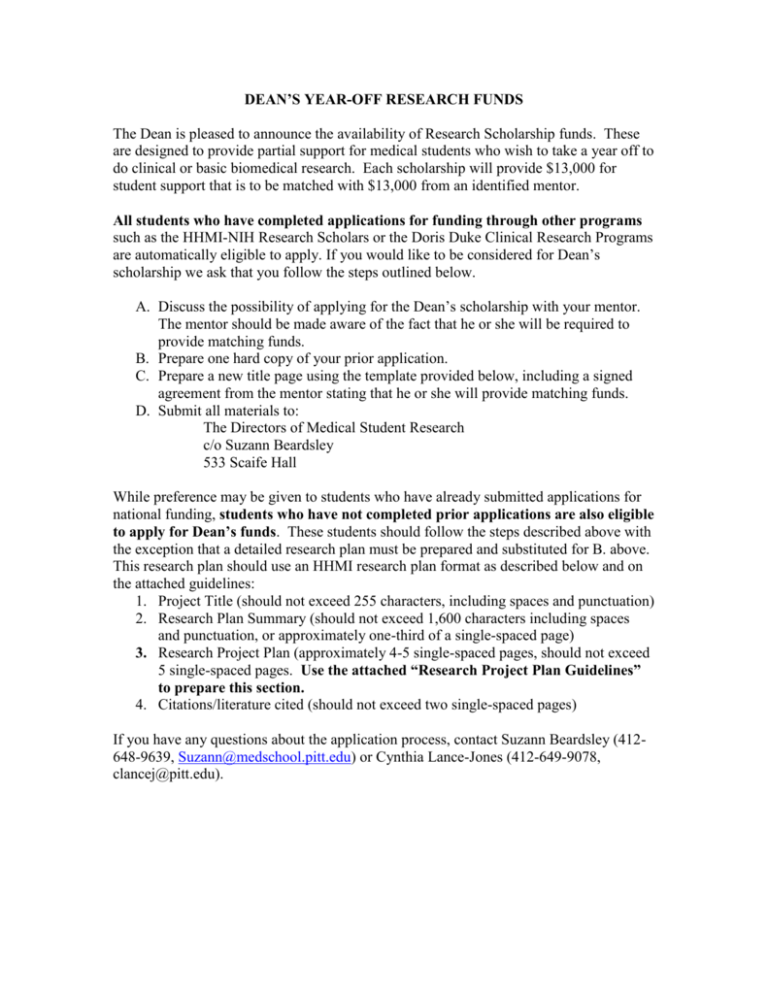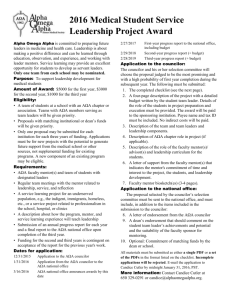Dean`s FELLOWSHIP DRAFT2011
advertisement

DEAN’S YEAR-OFF RESEARCH FUNDS The Dean is pleased to announce the availability of Research Scholarship funds. These are designed to provide partial support for medical students who wish to take a year off to do clinical or basic biomedical research. Each scholarship will provide $13,000 for student support that is to be matched with $13,000 from an identified mentor. All students who have completed applications for funding through other programs such as the HHMI-NIH Research Scholars or the Doris Duke Clinical Research Programs are automatically eligible to apply. If you would like to be considered for Dean’s scholarship we ask that you follow the steps outlined below. A. Discuss the possibility of applying for the Dean’s scholarship with your mentor. The mentor should be made aware of the fact that he or she will be required to provide matching funds. B. Prepare one hard copy of your prior application. C. Prepare a new title page using the template provided below, including a signed agreement from the mentor stating that he or she will provide matching funds. D. Submit all materials to: The Directors of Medical Student Research c/o Suzann Beardsley 533 Scaife Hall While preference may be given to students who have already submitted applications for national funding, students who have not completed prior applications are also eligible to apply for Dean’s funds. These students should follow the steps described above with the exception that a detailed research plan must be prepared and substituted for B. above. This research plan should use an HHMI research plan format as described below and on the attached guidelines: 1. Project Title (should not exceed 255 characters, including spaces and punctuation) 2. Research Plan Summary (should not exceed 1,600 characters including spaces and punctuation, or approximately one-third of a single-spaced page) 3. Research Project Plan (approximately 4-5 single-spaced pages, should not exceed 5 single-spaced pages. Use the attached “Research Project Plan Guidelines” to prepare this section. 4. Citations/literature cited (should not exceed two single-spaced pages) If you have any questions about the application process, contact Suzann Beardsley (412648-9639, Suzann@medschool.pitt.edu) or Cynthia Lance-Jones (412-649-9078, clancej@pitt.edu). TEMPLATE FOR TITLE PAGE University of Pittsburgh School of Medicine Application for Dean’s Research Scholarship Project title Dates of proposed research period Student name Medical School Class email address telephone number “I agree that reviewers of this application may have access to my medical school transcript record of grades.” Student signature Mentor name Title Department/Division Affiliation email address telephone number “ I have read and approve this research proposal. I agree to provide $11.000 matching funds for student support as well as any funds required to carry out the proposed research.” Mentor signature Relevant IRB or IACUC approval number or exemption, if applicable. RESEARCH PROJECT PLAN GUIDELINES Research plan. The research plan should be appropriate to develop skills needed by a researcher. Projects that lack a clearly stated aim or hypothesis, such as studies involving routine data gathering to see where leads might develop and other types of descriptive projects, usually do not receive favorable recommendations from reviewers. This also applies to projects that describe more work than can be done by a student in a year, as well as more routine projects that might be done by a skilled technician. Prepare the research plan with the following sections using the guidelines provided. These guidelines are very similar to those used for HHMI training fellowship applications. The research plan should be typed single spaced at 12 point font. It should not exceed 3 single spaced pages, excluding the references (f. Literature cited) a. Specific Aims. List the broad, long-term objectives and what the specific research proposed in this application is intended to accomplish, e.g., to test a stated hypothesis, create a novel design, solve a specific problem, or develop new technology. Generally, a research proposal can be broken down into 2-4 specific aims. (approximately 1/3 to ½ page) b. Background and Significance. Briefly sketch the background leading to the present application, critically evaluate existing knowledge (including research by the mentor, if applicable), and specifically identify the gaps that the project is intended to fill. State concisely the importance and medical relevance of the research. (approximately ½ page) c. Preliminary Studies. Briefly describe any data that you (the student) has already obtained relevant to proposed research. Do not describe research that is not related to your proposed experiments. This section is not required if you have yet to carry out work in your mentor’s laboratory. (approximately ½ page) d. Research Design and Methods. For each specific aim that you have listed above, briefly describe the experiments that you will carry out and the methods to be used. Include how the data will be collected, analyzed, and interpreted. Be sure to briefly mention possible outcomes and their significance as well as any pitfalls that might be encountered. (approximately 1½ -2 pages) e. Statement of Interest in a Year-off Research Plan. Briefly describe why it is important for you to pursue a year of research at this stage in your training. What will this research help you accomplish in the long term? (less than ¼ page) f. Literature cited. List all references using the following format: Author (s). Article title. Journal title. Volume: pages. Publication year. (limited to 1 page)






